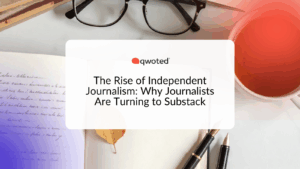I suppose if you (or I) read another damn story about how much COVID-19 changed everything in 2020, we’re going to have to throw a bowling ball against the nearest sheet of wafer-thin drywall in our homes-turned-offices. Yet while the pandemic wins the As Obvious As The Nose On Your Face Award for disrupting every profession in 2020, we can still take a fresh look back at the antipodes that rocked the media: acceleration and deceleration.
Scientifically speaking, the coronavirus resembles a demon-possessed jackfruit and shows no mercy. But in terms of content and journalism, it has acted as a catalytic. It splashed fuel onto the field and set it ablaze. The tech heavies I know put it this way: “Lou, what we thought would take seven years to accomplish compressed into seven months.” It’s been the year of Zoom and even Zoom Fatigue. Who even knew what Zoom was just a year ago?
Here I want to highlight just a few news-about-news highlights from the year that riff on speeding up and slowing down. For where it comes to the things we can’t control—the broader currents of pandemic, social upheaval, and a pivoting profession—wishing away the force of change will not make it so. These three touchstones marked a year that impacted world health, our profession and each one of us like no other.
The Freelance Free for All
No matter what anyone tells you, especially talking heads from freelance worker gulags like Upwork and Upyourasswork, this is not a life many, many journalists and content specialists chose. I know. I became one of those people in 2020. Pew Research Center notes that the number of newspaper newsroom employees dropped by 51% between 2008 and 2019. This makes Upwork’s contention that “61% of freelancers went into this type of work by choice” sound like the brainchild of election-steal conspiracists who have no proof to back up their fantasy claims other than some half-cocked survey numbers. Freelance pay as a whole averages $16 an hour. That does not sound like the career move any award-winning writer, editor or photographer dreams of making. Unless backsliding, losing your health insurance and sayonara 401(k) and 401(k) match are your thang.
But in 2020 we saw newly-minted and repurposed freelancers turn up the heat speed-wise. A wonderful new piece from Molly McCluskey for the Poynter journo think tank tells the story of Lucy Sherriff, a long-form investigative journalist who, having had some of her international reporting trips cancelled, literally had to “think fast”:
When an editor she knew reached out with work, in a move echoed by many of us, the long-form investigative journalist didn’t hesitate to start churning out quick-hit, breaking news pieces, even though it ultimately burned her out. “It was exhausting work, but basically, it saved me,” Sherriff said. “I just had to do whatever I had to do to stay afloat.”
Newspapers, magazines and all sorts of platforms have had to work equally hard to stay afloat. I imagine that’s true of Poynter as well, a non-profit I admire. Molly McCluskey is, after all, is not on staff. She’s a freelancer.
Technology Bounds and Leaps
At Qwoted, we like to think that 2020 allowed us to serve more journalists than ever by bringing a graceful, user-friendly tech platform to everyone’s doorstep. Go ahead and groan at the self congrats. But hey: Muhammad Ali once said, “It ain’t bragging if you can do it,” and we did.
To be sure, Qwoted was part of a much larger arch that saw reporters turn to tech like never before. If the long, long lines at computer stores offer any indication, writers everywhere souped up their laptops, smartphones and home offices. And when they got onto Zoom (or, for my money, the far superior Google Chat), they actually started interviewing people face to face again, even if via screen. The omnipresence of email and cellular have made that kind of work increasingly rare, and when you see someone’s face and dress as you interview them, you land a gold mine of details in body language that sharpen your perspective. When a source says, “Our company is doing great!” but their head is cast down, that is one helluva rich tell-all.
Meanwhile the Washington Post‘s Harry Stevens delivered a triumph on March 14, right at the outset of the pandemic, with a dynamic piece, “Why outbreaks like coronavirus spread exponentially, and how to ‘flatten the curve.’” The graphics in this article boasted real-time motion, and provided readers with delightful eye candy (such a dots scattering like marbles) that illustrated the story in a way no newsprint or even video could hope to duplicate. It proved so popular that the Post has translated it into more than a dozen languages as of this writing. It was, by one staffer’s account, the most-read online piece in the Post’s history.
Not to be outdone, The New York Times released, “How the Virus Got Out,” which used Twitter-sized text blocks. As the reader scrolled down to read them, maps and graphics appeared that showed how the coronavirus spread from Wuhan to across the world. It kept readers riveted, including yours Lou-ly.
Stepping Up by Stepping Back
The business of busy-ness in an industry driven by deadline has perils that spill over into the home. It’s rare that anyone takes a break without guilt. Two-week vacations? Those were still common when I broke into the business decades ago. Nowadays, if you take more than a week off, you worry about how that makes you look.
But with the pandemic many of us, perhaps all of us, took time off regardless of how we felt about it. Some of us lost jobs. Freelance gigs folded. Unemployment claims skyrocketed. Others like Lucy Sherriff couldn’t wing abroad for business and so winged it instead. (Bravo to you, Lucy!) Or, given the imperative to work at home, we found new ways to flex time by the grace of God and the cursing of micromanaging bosses no longer able to haunt our cubicles sans invitation. Socially distanced and isolated, we suddenly had more time to pray and meditate in advance of the wheels spinning out of control in our heads.
This led many more of us to reconsider everything. Lord knows I did, too. We accelerated our deceleration, so to speak. Forced to slow down or cut beloved routines from the schedule, we had the rarest of chances to look at the ladders we were climbing and decide whether they really leaned against the right wall. Or if those ladders rotted and fell out beneath us, the next question after dusting off our bruised bums was, “Now what?”
Now What? Now This: This Is Now
“Now what?” That was and is both the short-term question and the longer-term one. Short term, I’ve had to scramble like hell. I’ve taken on gigs that you file under “Pit in the Stomach, Pain in the Ass.” When I tell my kids these days to follow their bliss, they think I’m a hypocrite. Many of my new assignments are journalistic in nature. Many are not. Perhaps the most unique was prepping a report to help save the fabled School of Rock. I should’ve been paid a Fender Stratocaster guitar for this. Dream on, pal.
The worst? I don’t like to dwell on that sort of stuff. But let’s just say it’s no fun to prep work for a client that doesn’t know what they want until you give it to them. Then you find out it’s not what they want. So you rewrite it and it’s still not what they want. “But what do you want?” you ask. “I’ll know it when I see it,” they reply. I lived this out with a client who, being dumber than a box of Pet Rocks, ignored what I told her: My father-in-law had just passed away, I was trying to get his affairs in order and pulled an all-nighter to deliver the goods. On time. Like a pro. Though she said otherwise, I did a great job and have the drafts on my laptop to prove it. As a freelancer, it is delicious to finally have the power to “fire” these idiots … though it also forces one to start hitting up LinkedIn contacts like crazy. (Lost income, ya know.)
And yet what a precious, precious time. Because longer term, “Now what?” demands a definitive answer. I must put aside what doesn’t matter and devote myself to what does. For those of us cast adrift in this media rowboat, professionally and for the profession, our circumstances are dire but our timing couldn’t be better. True: Journalism has been dying and getting reborn for some time. Sometimes, I barely recognize it. Fake news is real, and the real fake news has convinced real people—not stupid, simply misled and mis-fed—that lies are truth and conspiracies are veracities.
In the face of this, I believe 2020 also accelerated the imperative to do better as a profession. And yes, we did. Called the Enemy of the People by an enemy of media people, we stood firm and did our jobs anyway. We pivoted. We improvised. We called out the true enemies of the people, some not so obvious. We pressured the likes of Facebook and Twitter to finally police themselves and learn the difference between freedom of speech and giving free exposure to irresponsible speech. Hate speech. Dangerous lies. We showed up. We advanced the craft. We adapted and adopted new technologies when COVID-19 dealt us an unprecedented blow.
As for 2021? We will—what else?—make headlines.
Lou Carlozo is Qwoted’s Editor In Chief. All views expressed are indecipherable and incomprehensible. lou@qwoted.com or connect on LinkedIn.



